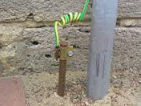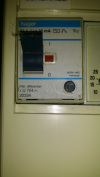
It is important that your electrical installation is correctly earthed. The first thing is to visually check for a cable, usually green and yellow, going from the fuseboard in your home through the exterior wall and connected to a metal pole in the grounds outside. This cable should be a minimum of 10mm thick.
All electrical devices with exposed metallic parts, e.g. washing machines, fridges, microwaves, have an earth in the power lead. When plugged into the socket, this makes connection to the earth running back to the fuseboard. For the 'earth' to be completed [bearing in mind this is the most important connection in the whole electrical installation] it runs through the cable and back to the ground. This completes the 'earth path'. We often see a lot of properties with undersized cable, which means that electricity is still travelling around and looks for the quickest path to the earth - it could be you!
The object of earthing an electrical installation is in the event of a fault on the live cables, the metal casing of your electrical equipment will also become live, because metal conducts. If you then touch this it will cause a dangerous electric shock of high intensity. [If your home has adequate RCD protection, this minimises the risk of shock]. This is because the current WILL pass through your body to connect to the earth. If your earth is correctly installed, the current will pass back down the earth path wire and safely back to the ground with no electric shock.

This process is of utmost importance if you do not have RCD protection at your fuseboard.
If you are concerned about either your earth connection and/or RCD protection, always seek the advice of a qualified Electrician.
 RSS Feed
RSS Feed
